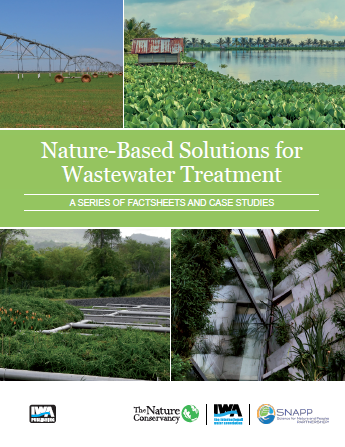It’s time to put nature at the heart of wastewater solutions
Nature often acts as a conduit for untreated sewage into water bodies, wetlands, or the sea. However, a planned approach using nature-based solutions (NBS) not only improves sanitation services, but also provide numerous co-benefits for both people and the environment.
In fact, NBS have been supporting wastewater treatment throughout history; ancient Egyptian and Chinese cultures were known to use wetlands for wastewater disposal. Over time, technologies were developed to treat the high pollution loads without destroying aquatic ecosystems.
In recent years, NBS have been hailed as an innovative solution to manage water-related risks including wastewater treatment, with growing investment from both public and private sectors. Some are old approaches such as soil infiltration and treatment wetlands which have been around for more than 100 years; others are more recent developments, such as floating wetlands and willow systems.
The benefits of using NBS in wastewater treatment extend beyond improvements in water quality, but can also provide habitat for flora and fauna, regulate temperature during hot weather conditions, mitigate floods and storm peaks, produce biomass and biosolids, sequester carbon and enable water reuse. Wider benefits can include providing space for recreation, improving aesthetic appeal and restoring landscapes, drawing people together and strengthening community ties.
New NBS publication
The recently released IWA and TNC publication “Nature-Based Solutions for Wastewater Treatment” is a starting point to identify and compare NBS options that can be incorporated into domestic and municipal wastewater treatment processes, with an emphasis on the potential co-benefits.
Building on the evidence base, the compilation of factsheets and case studies in the publication detail a selection of NBS as part of the process of treating domestic wastewater, while also providing ecological and social co-benefits. Case studies are provided for most NBS options, illustrating how these nature-based wastewater treatment approaches have been applied in practice.
Ten key lessons have been distilled from the factsheets and case studies showing both what NBS can provide and what needs to be considered when assessing NBS options for wastewater treatment.
- NBS can provide a long-term cost-effective option for treating wastewater – NBS are often more cost-effective in terms of energy, environmental impact, durability and maintenance than conventional wastewater treatment approaches.
- Different NBS can be combined for wastewater treatment – Different configurations of NBS are detailed in the publication factsheets. The combination depends on influent characteristics and treatment objectives, as well as available land, labour, and energy.
- Combining NBS with grey infrastructure can lower costs and provide more resilient services – Integrating NBS into grey infrastructure such as using treatment wetlands for tertiary treatment or polishing, or reuse of wastewater using soil inflitration can cost-effectively improve effluent water quality, promote resilience and provide multiple benefits to communities.
- NBS can be part of centralised or decentralised wastewater treatment systems – Not all NBS require a large amount of space so can be used as part of centralised and decentralised systems in urban and rural settings. High surface area demands can be overcome by vertical design (living walls) and positioning on roofs (rooftop wetlands) in densely populated urban settings.
- Simpler maintenance does not mean no maintenance – NBS used for wastewater treatment need to be maintained to ensure treatment efficiency and prevent negative impacts to the supporting ecosystem.
- Application of NBS may require trade-offs – Planners and practitioners should carefully assess trade-offs at the outset of project development, such as the investment costs needed to meet regulations, or what the land being used to treat wastewater could be used for instead (e.g. agriculture).
- NBS must be tailored to local conditions – Application of NBS is context specific and needs to be designed and implemented to meet local conditions and needs, while also carefully considering any trade-offs.
- Cost–benefit analyses need to consider the co-benefits of NBS – There are a growing number of economic valuation tools which account for the co-benefits of NBS technologies, providing a clearer view of the value of integrating NBS into wastewater treatment processes.
- The transition to a circular economy is an opportunity to promote the use of NBS in wastewater treatment – NBS can support a circular approach as they often enable resource recovery such as water reuse, production of biomass and the collection of biosolids.
- A multi-disciplinary, integrated approach can maximise the potential of NBS – Implementation of NBS requires the involvement of different stakeholders from the design stage to secure co-benefits and successful implementation. For example, this can mean a biologist to advise on how to protect habitats and biodiversity, landscape designers to provide recreation spaces, communiy members to provide feedback and ensure buy-in, and engineers to design the system.
The “Nature-Based Solutions for Wastewater Treatment” publication was developed by the Sanitation for and by Nature (NatureSan) working group, co-led by the International Water Association (IWA) and The Nature Conservancy (TNC). It is available to purchase through IWA Publishing https://www.iwapublishing.com/books/9781789062250/nature-based-solutions-wastewater-treatment
The NatureSan working group has been supported by the Science for Nature and People Partnership (SNAPP) and the Bridge Collaborative, and has worked in collaboration with the IWA Task Group for NBS for Water and Sanitation. The process brought together a diverse group of professionals to showcase and demonstrate the benefits of investing in nature as part of wastewater treatment in a way that supports healthy environment and people.


